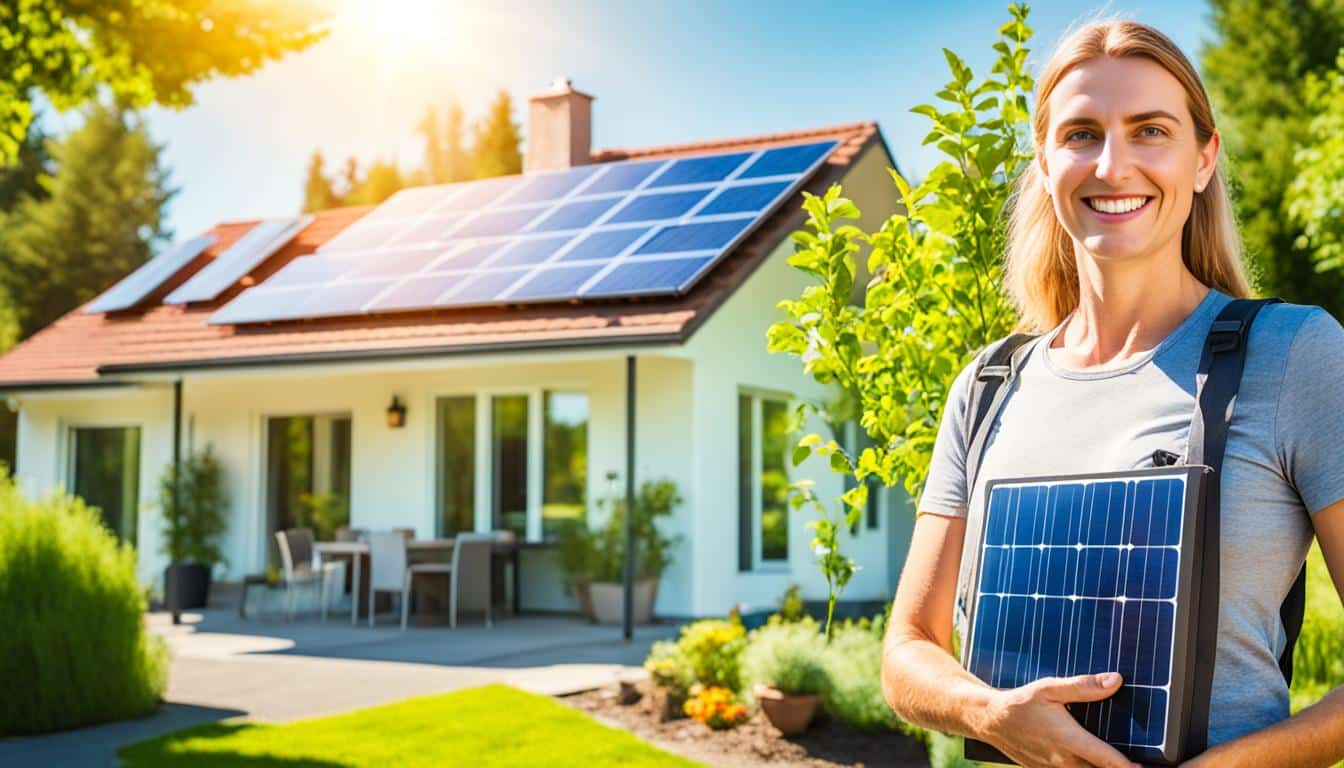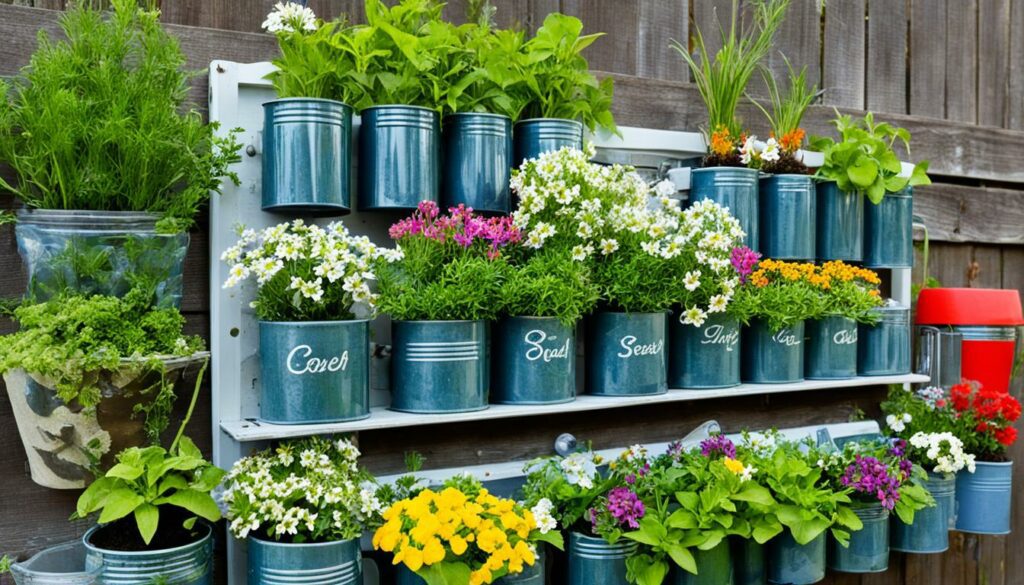Menu

Did you know that turning down your water heater can save lots of energy? You can do this without affecting what you do every day. It’s just one part of many steps we can all take to lower our carbon footprints. Learning how to live sustainably helps us reduce our impact on the planet.
On average, each home releases around 10 tonnes of CO2 each year. We can bring this number down a lot by using energy wisely. Start with simple things like turning off lights you don’t need or drying clothes outside. These steps help save energy at home or at school. Don’t forget to unplug things that stay on standby. This also helps cut down on electricity use.
Controlling indoor climate is also important. Setting the thermostat a bit lower in winter and higher in summer can save a lot of energy. It’s also good to make the most of natural light and air through windows. This helps heat and cool our homes better, making our lifestyles more sustainable.
Sharing appliances and turning off gadgets when they’re not in use are great habits. They help slim our carbon footprints and aid in protecting our earth. Every little step towards saving energy is a big win for the environment.
Before starting a climate-saving plan, it’s key to know what a carbon footprint is. We need to understand how it affects the environment. This is the first step to reduce our impact on the planet.
A carbon footprint is the total of greenhouse gases we create. This includes mainly carbon dioxide (CO2). It’s from our everyday activities like driving, using energy at home, and shopping. For example, a family of four can make 10 tonnes of CO2 in a year. This shows how our daily choices affect the earth.
To measure our carbon footprint, we count all the emissions from what we do. There are tools to help like carbon calculators. They look at our energy use, how we get around, what we eat, and how we deal with waste. This detailed look helps us find where we can do better. Then, we can pick the best ways to help the planet.
A big part of our carbon footprint is from our homes, making up about 30%. We can reduce this by checking our energy use at home. This includes having home energy checks and using appliances with the ENERGY STAR® label. Making these changes can cut down our carbon footprint. It also leads to a more eco-friendly life.
By knowing and measuring our carbon footprints, we’re on the right track. It helps us use smart strategies to lower our impact on the environment.
With more people working from home, it’s key to be energy-efficient. Using renewable energy and eco-friendly habits cuts down on power use and carbon footprints hugely. Swapping to renewable energy and using energy-saving appliances in your daily life are big steps forward.

For a lower carbon footprint, switch to renewables at home. Solar panels and wind energy turn nature’s gifts into power without the harmful gases. Solar panels turn sunlight into power cleanly. Wind turbines are efficient and last a long time.
Setting your water heater to 120°F (around 49°C) is simple and green. It uses less power, saving you money. Even dropping the temp by 1°C can cut heating costs by 8%.
| Setting | Energy Savings | Benefits |
|---|---|---|
| 120°F (49°C) | 8% cut in heating costs | Less energy use, lower bills |
| Warm Cycle Washing | Uses 50% less energy than hot | Cost-effective, eco-friendly |
| Cold Cycle Washing | Even less than warm | Furthest cut in energy use |
Choosing energy-saving appliances is crucial for a green home. Look for ENERGY STAR® ratings for more efficient use of power and water. This reduces bills and your impact on the planet.
Introducing renewables, tweaking your water heater, and getting energy-efficient devices are powerful. They lead to major savings in energy, cut down on carbon, and lower your bills. This way, we all move towards a greener world.
It’s key to use smart strategies for your home’s heating and cooling. This helps cut energy use and live more sustainably. New techniques and tech can boost energy efficiency and lower your carbon footprint.
Changing your thermostat by 5 degrees based on the season can save a lot of energy. This means more eco-friendly living. Adding smart controls to your HVAC also helps save energy. So does upgrading to energy-efficient models.
Insulation, especially near windows and doors, makes a big difference all year. It keeps your home warmer in winter and cooler in summer. This not only helps save energy but also reduces your carbon footprint.
Better insulation, along with efficient windows, works great with renewable energy sources like solar panels. It means you use less fossil fuels and lower carbon emissions.
Looking after your heating system is crucial for living sustainably. A well-tuned system saves a lot of energy. High-efficiency heat pumps are a good choice and work better with regular checks.
Advanced energy monitoring helps too. It gives you tips on using less energy, which decreases carbon emissions.
Working with pros in heating and cooling can really help. They might recommend up-to-date systems and more. This cuts your energy use and carbon footprint. For expert tips and strategies, check out this guide.
Reducing energy use is key to lessening our impact on the planet. By making eco-friendly choices daily, we can help a lot. Let’s look at some easy habits for everyone to start doing.
Turning off lights and appliances is a simple way to save energy. It not only lowers your power use but also your bills. Getting into the habit of switching things off can really help the planet.
Leaving appliances in standby uses energy too. Turn them off fully to save even more. These small actions over time can cut down your energy use a lot.

Eco-friendly lighting saves a lot of energy. CFLs and LED bulbs use less power and last longer. Pick these types of bulbs to lower your energy needs and costs.
| Lighting Type | Energy Usage | Lifespan |
|---|---|---|
| Incandescent | 90% wasted as heat | 1,000 hours |
| CFL | Less than 75% | 8,000 hours |
| LED | Less than 25% | 25,000 hours |
Small eco-friendly actions add up to big energy savings. Every effort helps the environment. Together, we can have a major positive effect.
Effectively saving water is key to cutting down on energy use and reducing carbon emissions. You can do this by using low-flow fixtures and water-saving devices. Doing these simple things at home will help a lot. It will lower the amount of water you use, which then lowers the energy needed.
Installing low-flow fixtures is an easy way to save water. Things like low-flow showerheads and taps use less water but work just as well. This saves both water and the energy needed to heat it. The approach to save water, as promoted by LADWP, also saves energy. It’s a win-win situation for both the environment and your wallet.
Shortening shower times helps save a lot of water. Water usage is linked to carbon emissions. A cubic meter of water used means 10.5 kg of carbon emissions. So, shorter showers really make a difference. They reduce both water use and the energy needed for heating it. This effort supports bigger plans for sustainable water use by regional and government bodies.
Using washing machines wisely can save heaps of water. Make sure you run your machine with full loads. This not only saves water but also cuts down on energy. LADWP’s advice supports using high-efficiency machines. They help you save water and electricity. This matters a lot in areas where water and wastewater are a big part of energy use.
Remember, combining efforts to save water and energy works well with using low-flow fixtures and other green habits. It leads to a greener life and lower greenhouse gas emissions. So, every small step counts towards a big positive change.
Sustainable transportation is key in reducing harmful emissions. In the United States, transport causes the most carbon emissions, mostly from cars. By using more eco-friendly ways to travel, we can cut down our pollution.

Carpooling is a great way to lower emissions. It cuts your travel costs by 40-50% if you do it often. Public transport is a good option too. It cuts down on emissions and saves people nearly $10,000 each year. Strong public transport systems can take 37 million metric tons of CO2 out of the air every year.
Another good step is choosing electric or hybrid cars. Sales are going up fast, with over 1.2 million EVs and 190,000 hybrids sold in 2023. The number of places you can charge EVs has also doubled in recent years. These cars are better for the environment and cost less to run.
Carpooling and using EVs are big wins for our planet. They help us move towards a cleaner future. It’s important to support these eco-friendly ways of travelling.
Adding eco-friendly habits to our day can really help the earth. Small changes make a big difference in saving our planet.
Less plastic means less trash. Use a reusable bag instead of a disposable one to cut down on plastic waste. Also, pick items with less plastic wrap or choose those packaged in materials that break down easily.
Choose local fruits and veg to help both the environment and nearby farmers. Local food travels a shorter distance, cutting down on harmful emissions. Plus, it’s often fresher and uses less energy to stay fresh. Eating this way supports the health of the planet.
Buy only what you really need to lessen your trash. High-quality items mean you buy less often, saving energy used during making. Clothes that are re-used or from the past save water and energy. Also, choosing eco-friendly brands pushes for better environmental actions from companies.
Adopting good recycling and reuse strategies is key to lowering our waste’s impact on the environment. They help cut down on harmful gases and save important resources.
Sorting waste right is the first step in smart recycling and reuse strategies. We need to separate materials like aluminium, PET plastics, and food waste. This ensures they are reused or recycled the best way. For example, recycling one aluminium can preserves the energy of making half of it new.
Getting involved in local recycling schemes is important. It makes sure tricky items, such as electronics or Styrofoam, are managed properly. By 2050, this could reduce a huge amount of carbon emissions.

Donating and reusing products is also crucial. It helps increase the use of clothes, gadgets, or furniture, saving the energy and resources needed to make new ones. Plus, it helps both the environment and those who could use these items.
The advantages of following effective recycling are shown in the table below:
| Material | Energy Savings | Challenges |
|---|---|---|
| Aluminium | 95% energy savings compared to raw production | Requires proper sorting and cleaning |
| PET Plastics | Energy savings depend on the recycling process used | Weakens with each recycling cycle |
| Organic Waste | Decomposition into useful compost | Produces methane if not properly composted |
By embracing recycling and reuse strategies, joining in local recycling programmes, and donating used items, we make our environment cleaner and greener for all.
Lowering your carbon footprint is key for leading a sustainable life. A straightforward move is setting your water heater to 120°F. This cuts the energy it uses to warm water, lowering your environmental impact.
Change your thermostat by five degrees in both winter and summer. It saves a lot of energy and reduces carbon emissions. Also, remember to turn off lights and unplug devices not in use. This simple step stops energy waste and helps cut your carbon footprint.
Swapping old light bulbs for LED or CFL ones will have a big effect. These new bulbs last longer and create less waste. Another good idea is to install low-flow showerheads. This saves water and also decreases your carbon output.
| Energy-Saving Action | Impact |
|---|---|
| Lowering Water Heater Temperature | Reduces energy usage, lowers carbon footprint |
| Thermostat Adjustment | Significant energy savings, reduced emissions |
| Switching to LED/CFL Bulbs | Energy efficiency, longer bulb lifespan, less waste |
| Using Low-Flow Showerheads | Conserves water, reduces carbon footprint |
Choosing ENERGY STAR® devices improves efficiency and cuts emissions. Also, picking wind or solar power reduces your carbon footprint. Many places offer these green options through Energy Choice programs.
Getting an energy audit can help spot where you’re wasting energy. Then, you can make those areas more efficient. Another big step is recycling. It cuts down on waste and supports the planet.
Good home insulation, especially around windows, makes a big difference. It keeps your home warmer or cooler without using as much energy. This positively affects your carbon footprint.
Using items that you can use over and over, not single-use plastics, is a great choice. And buying things that are well-made and last helps, too. Plus, backing businesses that care about the environment and buying carbon offsets can offset some of your unavoidable emissions.
Setting up green initiatives in the office is vital. It helps cut down on the business’s carbon footprint. This is done by using less energy, choosing green ways to travel, and reducing the need for paper.

Using less electricity is key to lowering office emissions. You can do this by using energy-efficient lights and smart power strips. A big part of an office’s harmful gases comes from heating. By tweaking the thermostats and making sure the building is well-insulated, you can reduce this too. Great management of the air conditioning and heating is especially important in places where it gets very hot or cold.
Travelling to and from work makes up a lot of the pollution an office produces. But, you can cut this pollution by carpooling, using public transport, or driving electric cars. It’s also helpful if your workplace offers car-sharing schemes or rewards for walking or cycling.
Going digital with documents is an easy way to produce less waste. By doing so, your office can save quite a bit of money every year. Also, using less paper means there’s less negative impact on the environment when making and getting rid of paper. This makes your office cleaner and kinder to the planet.
By following these green strategies, companies help the planet and inspire a culture of caring for our world. Everyone plays a part, from using less energy to finding green ways to travel, and even by going paperless. All these steps together lead to a healthier environment for us all.
Technology helps a lot in cutting down our carbon footprint. This ranges from smart home devices to high-tech energy monitoring systems. These advancements play a key role in saving energy and pushing for sustainability.
Smart home devices change how we use energy at home. They can control lights, the climate, and appliances to save energy. Smart thermostats, for example, adjust the temperature based on if someone’s home or the weather. This can save a lot of energy and money, which helps the environment.
Energy monitoring systems are vital for finding ways to use energy better. They give us real-time info on how much energy we use. With this information, we can find and fix places where energy is wasted. By doing so, we can lower our impact on the environment. The clear view these systems give us on our carbon usage can lower emissions by 40%. So, they are crucial for our eco goals.
Using efficient home appliances is key to saving energy and cutting our carbon footprint. New appliances, especially those with ENERGY STAR ratings, are much more energy-efficient. This includes appliances like washing machines and fridges. Also, as solar panel costs dropped by 85% from 2010 to 2019, combining these with eco-friendly appliances brings even more benefits.
With the growth of technology, adding smart home devices, top-notch energy monitoring systems, and green appliances into our routines is critical. It’s essential for significantly lowering our carbon footprint. In the face of serious climate challenges, using these innovations is not a choice. It’s something we must do.
Community sustainability needs everyone to take part. Climate action groups are a key way for locals to team up. They aim to cut down on emissions and spread green habits.

Starting climate action groups in your area is a great approach. In these groups, people swap tips on how to lower their carbon footprint. Similar to the UK aiming to slash emissions by 68% before 2030, local groups set their sights on these goals too. For example, Glasgow’s plan brought together 24,000 people online to share 1,300 ideas.
Greenwich’s project let locals choose places for new charging points. It encourages using cars that produce less pollution.
Teaching others about green ways is vital for success. Sharing useful tools and info widely brings more people to the table. For instance, Haringey used a Design Feedback tool from Commonplace. It helped get advice from the community for their Eco goals.
In Camden, they used a special map to gather ideas in the early stages. These ideas will create a detailed plan for saving local wildlife and making the area greener.
Here are some projects run by the people and what they’ve achieved:
| Initiative | Location | Engagement | Outcome |
|---|---|---|---|
| Climate Action Plan | Glasgow | 24,000 views, 1,300 contributions | Enhanced community participation |
| Lamppost Charging Points | Greenwich | Community input on locations | Behaviour change towards low-emission vehicles |
| Solar Farm Project | Essex | 1,990 visitors, 217 contributions | Increased support for renewable energy |
| Biodiversity Action Plan | Camden | Ideas collected via heatmap | Will feed into action plan |
Manchester aims to be carbon-neutral by 2038. This big vision involves many groups working together. With a population of 2.85 million, this effort shows how partnerships can make greener, better living possible for all.
Many of us struggle to cut emissions further to reduce our carbon footprint. Carbon offsets come in here, letting people and firms balance their emissions. They do this by funding projects that reduce or remove the same amount of carbon dioxide.
Carbon offsets cut a definite amount of greenhouse gas emissions. Usually, each one equals a metric ton of carbon dioxide. They help projects like conserving forests and green energy. Forest-saving projects are common because they are key in fighting climate change.
Picking ethical offset programmes takes thought to ensure they do good and are reliable. Large firms like Google check closely the carbon offset projects they support. For individuals, looking for Green-e Climate’s certification helps spot reliable sellers. Projects backed by groups like the Climate Action Reserve stick to strict guidelines, ensuring their quality.
Carbon offsetting does more than balance emissions. It mainly helps stop more environmental harm by preventing emissions. Also, offset projects often benefit society and the economy, following several Sustainable Development Goals.
Top companies like Apple, Amazon, and Walmart aim for zero net emissions. This shows how important offsetting is in their sustainable growth plans. They trust in its power to mitigate harm.
Offset projects are closely watched through strict checks. These checks make sure they work. They also must bring good to local communities, improve health, and create jobs. Investing in various offset projects can deliver a lasting impact. It can also help keep offset costs stable over time.
To sum up, choosing ethical carbon offsets is a smart move to help the planet. It’s key to look for credible and certified programmes. Doing so maximises the good they can do for the environment and society.
Reducing our carbon footprint is not easy, but it can be done with daily choices and staying informed. Turning off lights when not needed and using energy-saving bulbs helps. So does shifting to green energy.
The health care sector alone causes 4.6% of the world’s emissions. No industry can ignore the need to cut pollution. By 2050, health care emissions could match those of 1.26 billion cars.
To fight this, supporting public health can make a big difference. This means more green spaces, active living, and healthy eating. It also involves better care for people with conditions like diabetes.
Even though we’ll still produce some emissions, carbon offsetting can help. This includes choosing sustainable foods and energies, plus new ways to remove CO2 from our air. Such actions are key in our fight against climate change.
Our planet is getting warmer, with severe weather on the rise. Protecting our environment is critical. Moving to a low-carbon future is a big task but also full of chances. It leads to a safer world for all to enjoy.
A carbon footprint shows how our activities affect the environment. It measures the greenhouse gases we make, especially carbon dioxide (CO2).
To calculate a carbon footprint, we use tools that look at CO2 from things like travel, energy use, and waste.
At home, use less energy by moving to green power, setting your water heater lower, and picking ENERGY STAR® goods.
Solar and wind power are good renewable choices. They lower your home’s carbon footprint and help our planet.
Change your thermostat by 5 degrees when needed. It saves energy, makes things more efficient, and cuts your carbon footprint.
Turn off lights and reduce standby. Choose lights that use less energy. These habits save a lot of energy every day.
Use less water by fitting taps and showers that don’t waste. Short showers and full washing machine loads also help a lot.
Carpool, use buses, or go for vehicles that don’t pollute much like hybrids. These are great alternatives reducing your carbon footprint.
Avoid plastic, buy food grown locally, and shop carefully. These habits are great for the planet.
Separate waste, join in local recycling, and give away or use old stuff again. These actions cut waste and help the environment.
Introduce rules that save energy, support green travel, and use less paper. These measures reduce an office’s carbon footprint.
Devices for homes, systems to check energy use, and efficient gadgets help a lot. They show how we can do even better for our planet.
Start a group, share what you know, and work with local leaders to make green choices. This makes your community focus on saving the planet.
Carbon offsets balance the CO2 you make by funding projects that cut the same. Choose verified offset schemes to ensure they really make a difference.
By offsetting, you help projects that lower CO2. This supports a full plan for taking care of our world.